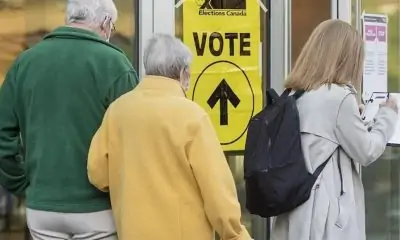AUSTIN, Texas (AP) — Trevor Etienne ran for three touchdowns, the first two set up by cornerback Daylen Everette’s takeaways, and fifth-ranked Georgia went on to beat Quinn Ewers and No. 1 Texas 30-15 on Saturday night.
Etienne’s last score was a 1-yard plunge on fourth down with 12:04 left. That came right after an ugly sequence when Texas fans littered the field with water bottles and other trash after referees called a pass-interference penalty that initially wiped out an interception and long return, before the flag was picked up and set up a Longhorns TD.
“These players bring the best out of me,” Georgia coach Kirby Smart said. “They tried to rob us with calls in this place. And these guys are so resilient.”
Georgia (6-1, 4-1 Southeastern Conference), which began the season at No. 1, has won three in a row since a 41-34 loss at then-No. 4 Alabama, when the Bulldogs overcame a 28-0 deficit and went ahead late during an exchange of long TD passes.
The Bulldogs never trailed in their first trip to Austin since 1958 to take on the SEC newcomer that had gotten through the first half of its schedule pretty much unscathed.
“Nobody gave us a chance. Everybody doubted us,” Smart said, then making a reference to ESPN’s “College GameDay” pregame show that broadcast from the Austin campus earlier in the day. “Did you watch the show this morning? I didn’t because I was in meetings, but I got 8,000 texts about it.”
Texas (6-1, 2-1) won at reigning national champion Michigan in Week 2 and had been behind for less than four minutes all season before facing the the back-to-back national champ before the Wolverines.
The 15-point loss was the most lopsided for a No. 1 team at home since Notre Dame’s 31-16 win at Pittsburgh in 1982, according to Sportradar, when Dan Marino was the Panthers quarterback.
“Unfortunately, we didn’t play our best football tonight, but we were still competitive. Hopefully, we get another crack at them,” Texas coach Steve Sarkisian said. ‘They’ve they’ve been the standard in college football now for about five, six, seven years and we played them really well in the second half.”
Georgia quarterback Carson Beck improved to 19-2 as a starter, including a 7-2 mark against ranked teams. He was 23 of 41 for 175 yards and finished with three interceptions, though Texas didn’t get anything out of the two he threw in the first quarter. The Longhorns had only 38 yards total when trailing 23-0 at halftime.
Jahdae Barron’s pick and 36-yard return to the Georgia 9 late in the third quarter came after contact with Arian Smith that drew a pass interference penalty. Sarkisian was irate at officials, then went to the far corner of the field where students sit signaling for them to quit throwing things.
As the debris was being picked up, officials were discussing the play and picked up the flag. Two plays later, Ewers threw a 17-yard touchdown to Jaydon Blue to get the Longhorns to 23-15.
Ewers completed 25 of 43 passes for 211 yards.
Everette’s blindside sack late in the first quarter jarred loose the ball from Ewers, and the defender recovered at the Texas 13 after several of his teammates had tried to pick up the fumble. That led to Etienne’s 2-yard TD for a 7-0 lead.
A 15-yard TD run by Etienne, with a late lunge into the end zone, made it 17-0 after Everette stepped in front of a receiver for an interception at the Texas 34.
“We all always say that takeaways come in bunches,” Everette said. “We practice taking small details seriously.”
Peyton Woodring kicked three field goals before halftime for Georgia, the last a 44-yarder as time expired after freshman Arch Manning, in for a second series, fumbled while being sacked.
The takeaway
Georgia: Smart got his 100th career win in 117 games over nine seasons. … The defense set the tone for the Dawgs, including seven sacks and forcing four turnovers that Georgia turned into 17 points.
Texas: This was the Longhorns’ biggest test so far in the SEC, and it turned into a jarring reminder of how difficult things can be in their new league. Texas has lost its last five home games against top-five opponents, since a win over No. 3 Nebraska in 1999 when they were in the Big 12 together.
Poll implications
Texas will fall out of the No. 1 spot, it is just a matter of how far. Oregon (6-0) is likely to take over at the top from No. 2, but Georgia could possibly replace the Ducks there. No. 3 Penn State and No. 4 Ohio State, whose only loss was at Oregon, were both off this weekend.
Up next
Georgia: Faces Florida on Nov. 2 in their annual game in Jacksonville, Florida.
Texas: At Vanderbilt on Saturday.
___
Get alerts on the latest AP Top 25 poll throughout the season. Sign up here. AP college football: and


























